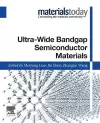
Ultra-wide Bandgap Semiconductor Materials
3 contributors - Paperback
£184.00
Meiyong Liao received his doctor of Materials Science at the Institute for Semiconductors, Chinese Academy of Science (Beijing, China) 2002. For two years he was a visiting researcher at Kyoto University, Japan. Then, he joined the Diamond Research Group at the National Institute for Materials Science, Tsukuba in 2004. Presently, he works as a principal researcher at NIMS on the topics of semiconducting diamond growth, device physics, and applications. He developed the world-record DUV diamond photodetector and proposed the photoconductive mechanism of diamond. He also proposed a novel type normally-off diamond transistor. He pioneered the semiconductor single crystal diamond MEMS/NEMS and demonstrated the SCD NEMS switch for the first time. He has been engaged in CVD diamond research for more than 15 years and published more than 150 peer-reviewed journal papers with more than 6000 citations. Bo Shen graduated in 1995 from Tohoku University, Japan, with a doctoral degree of Materials Science. In 2000, he was promoted as the Professor in Nanjing University, China. He moved to Peking University in 2004 as a Professor. Prof. Shen was awarded the National Science Fund for Distinguished Young Scholars of China in 2003. In 2004, he became a Chang Kung Scholar Professor. He is also the visiting Professor/Researcher of Tokyo University, Tohoku University, and National Institute of Advanced Industrial Science and Technology (AIST), Japan. He has been engaged in the research of III-Nitrides semiconductors for more than 20 years. He is a chair of several National Projects of China on next-generation wide-bandgap semiconductors. His research interests include growth and physics of quantum structures based on wide-bandgap semiconductors. He has published more than 200 papers in refereed academic journals with more than 3000 citations. He has also been the chair and on the organizing committee of several international conferences on wide-bandgap semiconductors such as APWS, E-MRS. Zhanguo Wang is a semiconductor materials physicist, and Research Professor in the Institute of Semiconductors, Chinese Academy of Sciences. Zhanguo Wang was elected as a Member of the Chinese Academy of Sciences in 1995. In the early 1960s, Wang was engaged in studies on radiation effects of silicon solar cells for satellites and the optical and electrical properties of semiconductor materials. From 1980, his main interests were on the deep level physics and spectrum physics of semiconductors. He and his colleagues developed a new method to identify whether the two deep levels within a band gap are coupled or not, thus solving the long existing fundamental question of gold-related donor and acceptor in Si, and A and B deep levels in LPE GaAs. He suggested a model of deep level broadening and PL spectrum splitting in semiconductor alloys. In 1986, he joined Professor Lin Lanying’s group, and the GaAs single crystal was successfully grown from the melt in space for the first time. In 1993, he proposed a multi-level compensation model and new criteria of electrical compensation for undoped SI-GaAs, which can not only explain the GaAs conductivity but also provide a clue for improving the quality of this material. Recently, he and his co-workers are working on low dimensional semiconductor materials (quantum well, quantum wires and quantum dots etc) growth and quantum devices fabrication. His group has also been engaged in the research of wide-band gap semiconductors of III-nitrides, ZnO, diamond, BN, etc. He has published more than 400 peer-reviewed journal papers and is the author of several academic books.